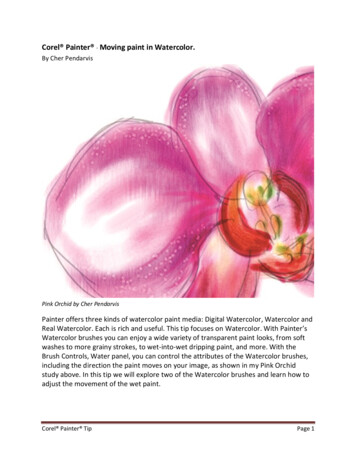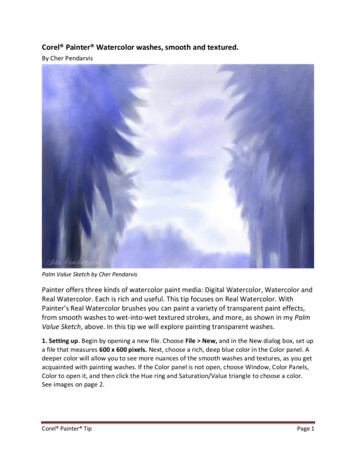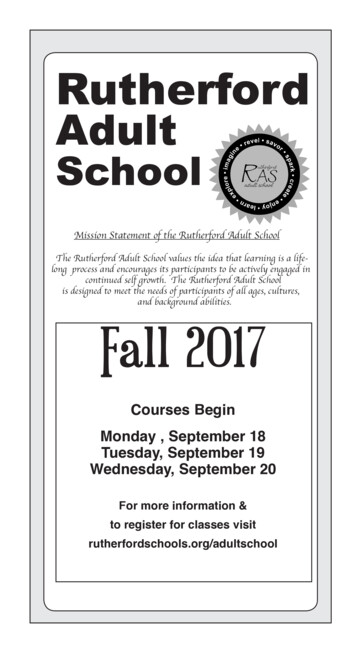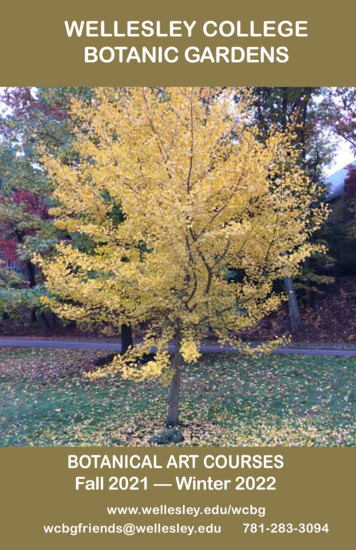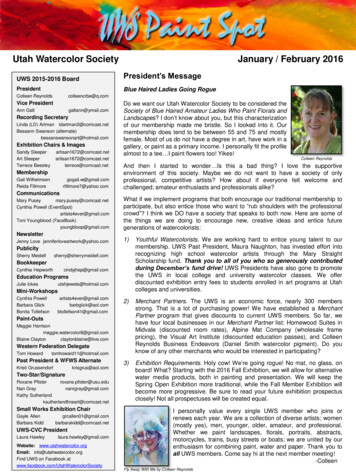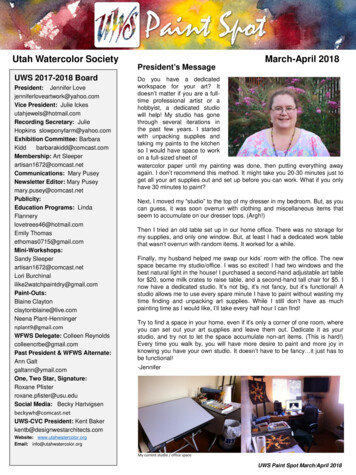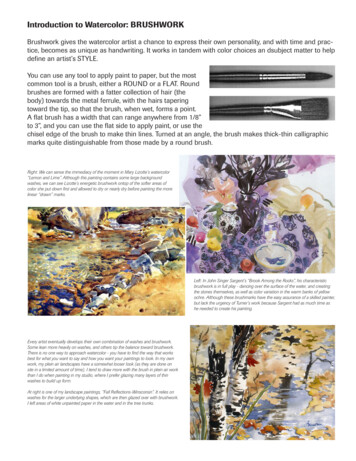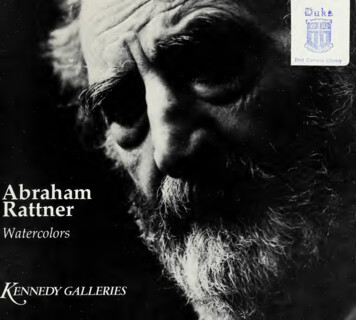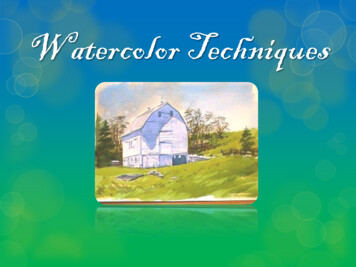
Transcription
Watercolor Techniques
Watercolor Technique ChartCATEGORYGOALS/OBJECTIVES: To learn different watercolortechniques. To find inspiration from historicallandscapes and from personalobservations. Get a basic watercolor foundationto be applied to their One PointPerspective Interior DesignGrowth ProgressDESCRIPTIONDoes it show more skills? Media application - watercolors - GrowthPTS20The painting illustrates the understanding of all sixdemonstrated techniques and includes a foreground,middle ground, and background.30The space created is unique. How original,innovative, and daring. Is the work compared toclass interior practices? Explored choices20CreativityWorkHabits/EffortMade good use of class time- Needed to bereminded- Student spend more time playing10Craftsmanship/skillsDrawing is neat, clean and complete. Lacks finishtouches – Average – Below Average- PoorRUBRIC:20Practice Grid: All six technique are applied and labeled Project gradeLandscape: The painting should illustrate the understanding of all six demonstrated techniques and include a foreground, middleground, and background. The scene should be from their favorite vacation spot—imaginary or real. Project gradeTest grade, students will write an expository paper about how they applied the techniques reflect on what they like and dislike orwhat would they have change or done different.1 Point Perspective Interior design Project grade See other lesson planGOALS-Objective Student will learn basic watercolor techniques and application
Watercolor A type of paint which is translucent (see-through). All paints are made by combining drypigment (color) with a medium. For watercolor paint, the medium for thepigment is water, so it is important to keepthe water clean! Used in China as early as the 3rd century. The method used today was developed inEngland in the 18th century.
Painting with Watercolor Watercolor paint is different from other types of paintbecause it is translucent and because there is no white. White areas in the painting must be planned ahead andleft white. If you make a mistake with watercolor, it can sometimesbe removed by adding clean water to the area andblotting it with a paper towel to pull up the color. Watercolor can be painted in layers. Once one layer isdry, it can be painted over and both layers will be visible. Watercolor can be painted on wet paper or on dry paper.
Watercolor PaperWatercolor paper comes in various weights and sizes. Rough – heavy texture Cold Press – fairly rough Hot Press – smoothWatercolor paper must be wet and stretched, then taped to a board toprevent it from wrinkling and curling up while painting.Cold press watercolor paper has texture. Little bumps and groves holds in thewater and pigment. It really sucks up the water pretty quickly. Cold press is agood choice when you want to convey texture in your subject.Hot press is super smooth. No texture with this paper. This paper doesn’t suckup the water as fast as the cold press, allowing you to play around more, likere-wetting edges of pigment.
Watercolor Technique Chart Water color techniques are used to create a variety ofillusions, special effects, and textures. You will make a chart that shows us how each techniqueworks. You will use a 9” x 12” piece of watercolor paper. Divide your watercolor paper into 6 rectangles using yourruler and pencil.123456
Watercolor TechniquesThe techniques you will be learning are:1. Wash -painting an even solid color.2. Graduated Wash – painting from dark to light (gradation with color)3. Wet on wet– Wet in wet is simply the process of applying pigment to wetpaper. Paint your paper with water, then add drops or lines of color with thepaint brush.4. Dry brush -paint using a dry brush and little or no water.5. Dropping in Color – This technique is simply the process of introducing acolor to a wet region of the painting and allowing it to blend bleed andfeather without interruption.6. Lifting Off – Most watercolor pigment can be dissolved and lifted off after ithas dried.
Wash / Variegated Wash A thin layer of paint that is laid over theentire paper surface, or a portion of it. Can be applied with a brush or a sponge. Must be applied quickly Paint is premixed and ready to usebefore you start the wash. One color is used. A variegated wash uses more than onecolor. Colors bleed into one another. Paint is applied to WET paper whichmakes the colors bleed together.
Gradated Wash A wash that shifts from dark tolight in one color. Applied the same as a wash,with more water added to yourpaint for each line of wash thatis laid down.
Watercolor Techniques Wet-in-wet-a process of adding paint into a wet areathat already has been pre-wet with clean water.
Watercolor Techniques Dry Brush –Brush loaded with paint onto dry paper.
Watercolor Techniques Lifting-Removing paint from the paper using a spongeor a soft paper towel.
Watercolor TechniquesThe techniques you will be learning are:1. Variegated Wash – painting a wash beginning with one color andending with another analogous color2. Salt-paint a wash, then sprinkle salt over the wet paint.3. Resist with crayon and tape - paint over resist material.4. Splatter-use a toothbrush to splatter color.5. Saran Wrap-paint a wash, then crumple the saran wrap over the wetpaint; remove when dry.
Watercolor Experiment PaintingAlcoholWet-in-wetWax ResistScratchingSplatteringSaltMaskingPlastic WrapTissue paper
Watercolor Techniques Glazing-Glazes are easy to accomplish using a littlepatience between steps. You must let each wash drycompletely before applying the next transparent layerof pigment.
Watercolor Techniques Alcohol-Drops of alcohol added to wet paint driesquicker than the surrounding paint to create a uniquetexture.
Watercolor Techniques Salt-Apply salt to wet paint areas of painting to create aspeckled texture.
Watercolor Techniques Splattering-The flicking of paint onto the paper. Stamping-Dabbing the paint onto the paper with asponge.
Watercolor Techniques Wax Resist-Wax is applied to areas you want thewatercolor pigment to repel the surface.
Watercolor Techniques Masking-Cover areas to preserve the white of thepaper. You can use tape or masking fluid.
Watercolor Techniques Plastic Wrap –Plastic wrap is applied to wet paint andthen removed after drying to create a textured look.
Watercolor Techniques Scratching –Scratch into wet paper to create texture.
Watercolor Techniques Tissue Paper –Tissue paper is applied towet paint and then removed to create atextured look.
Watercolor Techniques The techniques you will be learning are: 1. Wash -painting an even solid color. 2. Graduated Wash -painting from dark to light (gradation with color) 3. Wet on wet-Wet in wet is simply the process of applying pigment to wet paper. Paint your paper with water, then add drops or lines of color with the
